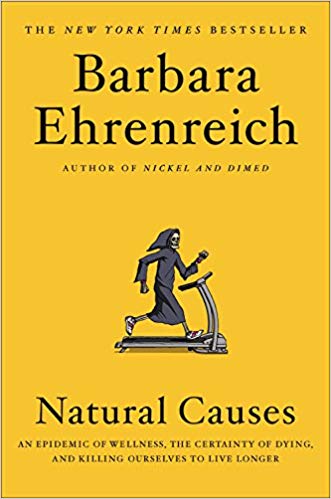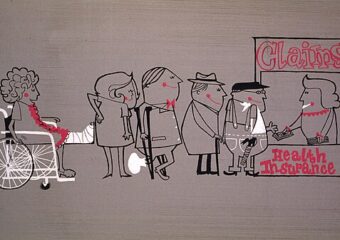Barbara Ehrenreich
Twelve
New York, NY
2018
234 pages
According to the Art:
Barbara Ehrenreich evaluates the balance between doing all that’s thought to be important to extending life and the time and energy it takes. She does this from the perspective of a person who is in her mid seventies (“old enough to die”) and healthy. She finds a balance that works for her but is at odds with what Biomedicine and related industries would have her do.
Synopsis:
Barbara Ehrenreich wants to manage her health and all that is available to address various aspects of it. She makes clear that she will do the managing and has written this book to reflect on how she plans to do it. Ehrenreich explains why managing her health is necessary. She puts it this way:
We would all like to live longer and healthier lives; the question is how much of our lives should be devoted to this project, when we all, or at least most of us, have other, often more consequential things to do.
p. xv
Ehrenreich doesn’t reject the project of getting longer and healthier lives per se, but she believes that what this project requires isn’t always worth the results it produces. The time and energy needed could be put towards better ends.
Like many other critics, Ehrenreich details how Biomedicine often comes up short on outcomes for all the time, effort, and money it requires from the people it serves. She covers the familiar territories of over diagnosis and over utilization of health care products and services, and goes further to suggest that many common medical practices are more ritualistic and humiliating than evidence-based and effective.
Unlike other critics, Ehrenreich takes on other activities directed at health outside of Biomedicine. She questions whether the physical fitness industry delivers on its promises to produce healthier lives and especially whether there is a net benefit based on the time and energy required from people who take it on. She crosses to the other side of the mind–body continuum when she next aims at the “madness of mindfulness.” (p. 71) She finds the mindfulness movement offers more hubris than solutions.
Ehrenreich worries that the combined effects of the authority of Biomedicine, the physical fitness frenzy, and the madness of mindfulness have created a social context that treats death as something that can be avoided or at least delayed. This social context thereby implies that not actively engaging in efforts to fight off death “can now be understood as a suicide.” (p. 97)
Ehrenreich offers some reasons for why these efforts to improve health and prolong life do not always produce benefits that in her view are worth pursuing to the exclusion of other activities resulting in a better life (or death). Drawing on examples from cell biology and immunology, she suggests that what is at work are disease processes too complex for the human mind to apprehend completely combined with the human impulse to simplify, which lead to practices, procedures, and prescriptions that in the best case are ineffective and in the worst case harmful.
At the end of the book, Ehrenreich laments the efforts health care professionals, nonprofit organizations, government agencies, and commercial entities make to push older people into commitments for “successful aging.” Those making these efforts argue “aging itself is abnormal and unacceptable.” (p. 164) This commitment requires older people to spend a lot of time in clinics, gyms, and wellness classes—“The price of survival is endless toil,” is how Ehrenreich formulates it. (p. 163) She doesn’t think this price is worth what is required of people who are supposed to benefit, and advises her friends to insist “on a nonmedical death, without the torment of heroic interventions to prolong life by a few hours or days.” (p. 208)
I continue to elude unnecessary medical attention and still doggedly push myself in the gym, where, if I am no longer a star, I am at least a fixture. In addition, I retain a daily regimen of stretching, some of which might qualify as yoga. Other than that, I pretty much eat what I want and indulge my vices, from butter to wine. Life is too short to forgo these pleasures, and would be far too long without them.
p. 207
Analysis:
Ehrenreich wrote this book in her mid seventies, and her age has a lot to do with her perspective. She is “old enough to die,” she says (p. 2), which to her means she is “old enough not to incur any more suffering, annoyance, or boredom in the pursuit of a longer life.” (p. 3)
In giving up on preventive care, I’m just taking this line of thinking a step further: Not only do I reject the torment of a medicalized death, but I refuse to accept a medicalized life, and my determination only deepens with age. As the time that remains to me shrinks, each month and day becomes too precious to spend in the windowless waiting rooms and under the cold scrutiny of machines. Being old enough to die is an achievement, not a defeat, and the freedom it brings is worth celebrating.
pp. 12-13
While it could be said that it’s easy for her to take this attitude at the age she writes the book, her views are not the province of only older people. Ezekiel Emanuel, writing in the July, 2014 issue of The Atlantic Magazine at the age of fifty–seven, took a similar view when he said he only wanted to live until the age of seventy–five.
I am talking about how long I want to live and the kind and amount of health care I will consent to after 75. Americans seem to be obsessed with exercising, doing mental puzzles, consuming various juice and protein concoctions, sticking to strict diets, and popping vitamins and supplements, all in a valiant effort to cheat death and prolong life as long as possible. This has become so pervasive that it now defines a cultural type: what I call the American immortal.
I reject this aspiration. I think this manic desperation to endlessly extend life is misguided and potentially destructive. For many reasons, 75 is a pretty good age to aim to stop.
Both Ehrenreich and Emanuel are bucking a trend. During the time they were writing about eschewing certain offerings and urgings of Biomedicine and related health promotion fields, consumers, health care providers, legislators, and mainstream media among others were pushing for broader and quicker access to health care technologies. They were even pushing and enabling easy access to unproven, unapproved, experimental drugs (e.g., state and federal right to try laws). These antipodes offer individuals two distinct approaches to managing their health and well being. Either one can be right for any person, and any person may prefer one approach during one phase of life and the other approach during another phase. Ehrenreich wants people to know they have a choice and that their preferences matter a lot.
Also:
A version of this review is posted at the NYU Literature, Arts & Medicine Database.
Montaigne had lots to say on this subject across many of his essays. I cover his views, which are very similar to those of Ehrenreich and Emanuel, in this blog entry.



